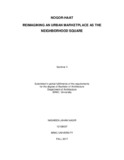| dc.contributor.author | Nasir, Nasheen Jahan | |
| dc.date.accessioned | 2018-05-21T08:03:03Z | |
| dc.date.available | 2018-05-21T08:03:03Z | |
| dc.date.copyright | 2017 | |
| dc.date.issued | 2017 | |
| dc.identifier.other | ID 12108037 | |
| dc.identifier.uri | http://hdl.handle.net/10361/10182 | |
| dc.description | This thesis is submitted in partial fulfillment of the requirements for the degree of Bachelor of Architecture, 2017. | en_US |
| dc.description | Cataloged from PDF version of thesis. | |
| dc.description | Includes bibliographical references (page 88). | |
| dc.description.abstract | With flourishing time, thriving technology and ever growing demand the rural fabric of Bangladesh is transforming into urban districts faster than we can comprehend and accommodate the traditional integral functions of Haat-bazaars into our neighborhoods. A city begins with people living together, forming a neighborhood and developing a community. In rural context „‟haat-bazaar‟‟ have been the focus of cultural and physical fabric of a village and other public functions grow surrounding it to create a community. In urban neighborhoods these bazaars exist out of need but fail to adapt to urban scale, demand and context. Thus it loses the traditional features of openness and spontaneity since it has no guidelines on adapting into an urban system. Consequently, bazaars faces traditional identity crisis and it no longer remains the center of a community as it once used to be.
Townhall is an old neighborhood node in Mohammadpur where the elements of the neighborhood center such as, ward Councilor office, bazaar, market, mosque, library, playground, park etc exist but faces structural vulnerability, political dispute, lack of integration, safety and security. In 2004 Dhaka north city corporation has decided to renovate 13 markets that were built in 1950‟s and are structurally failing, posing threat to the users. Townhall supermarket in Mohammadpur, is one of the markets which are to be demolished and rebuilt as a multi storied modern market. However, this site has the potential to be more than a mere market but the center of the neighborhood community if the different functions are thoroughly analyzed and integrated.
The aim is to redevelop the area by rejuvenating the functions, preserving and connecting the open spaces; thus creating a vibrant neighborhood square where the community market/bazaar would be at the center. The prime objective was to preserve the informal characteristics of a traditional bazaar bringing a systematic balance into the different types of formal and semi-formal markets and municipal functions. The necessity of an urban square to hold outdoor public events and festivities and have been considered a top priority as the city demands more open spaces that can hold activities created by the urban built programs. | en_US |
| dc.description.statementofresponsibility | Nasheen Jahan Nasir | |
| dc.format.extent | 88 pages | |
| dc.language.iso | en | en_US |
| dc.publisher | BRAC University | en_US |
| dc.rights | BRAC University thesis reports are protected by copyright. They may be viewed from this source for any purpose, but reproduction or distribution in any format is prohibited without written permission. | |
| dc.subject | Nogot-haat | en_US |
| dc.subject | Urban marketplace | en_US |
| dc.subject | Townhall | en_US |
| dc.title | Nogor-haat : reimagining an urban marketplace as the neighborhood square | en_US |
| dc.type | Thesis | en_US |
| dc.contributor.department | Department of Architecture, BRAC University | |
| dc.description.degree | B. Architecture | |

